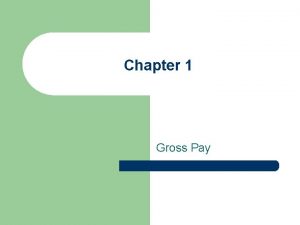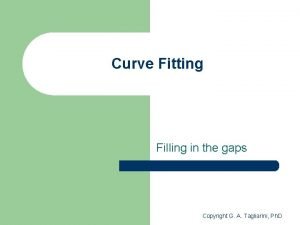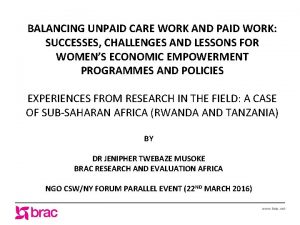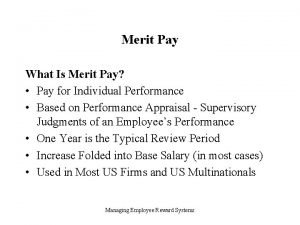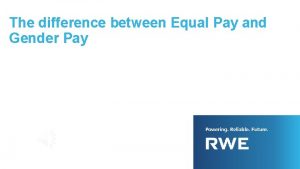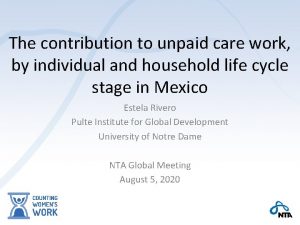Unpaid Care Work and Gender Pay Gaps in






















- Slides: 22


Unpaid Care Work and Gender Pay Gaps in China Xiao-yuan Dong University of Winnipeg Mexico City September 10 -11, 2018

Motivation This presentation examines the gender pattern of unpaid care work and its’ effect on gender earnings gaps in China, using data from the 2008 China Time Use Survey (CTUS). In China, as in other countries, the bulk of unpaid care work is performed by women at home, and is largely unpaid. The economic value of unpaid care work amounted to approximately one-third of China’s GDP in 2008, and more than 70 percent of that value was contributed by women (Dong and An 2013). While unpaid care work is essential for human wellbeing, the responsibility for unpaid care work limits women’s ability to participate equally with men in the labor market.

Employment Rates of Men and Women Aged 18 -64 in Urban China (%) Source: ACWF, The 1990, 2000 and 2010 waves of Chinese Women Social Status Survey

Labor Force Participation Rates, Selected Countries, 2013 (%) Source: OECD https: //stats. oecd. org/index. aspx? Data. Set. Code=LFS SEXAGE I R, page 15 -64, except China which is from CHIP, ages 15 -60, formal urban only.

Female-to-Male Earnings Ratio in China, by Sector (%) Source: ACWF, The 1990, 2000 and 2010 waves of Chinese Women Social Status Survey

Gender Wage Gaps, Selected Countries Source: ILO http: //www. ilo. org/wcmsp 5/groups/public---dgreports/--dcomm/--publ/ Documents/publication/wcms 324678. dpf

Literature Review Women not only spent more time on unpaid care work than men, but they also spent a larger proportion of unpaid work time on those activities that need to be performed on a daily basis and at specific times during the day (Noonan 2001; Hersch and Stratton 2002). As a result, women’s unpaid care work is more intertwined with their paid work than men’s (Bonke et al. 2005; Qi and Dong 2016). The gender differences in the amount and the timing and flexibility of unpaid care work are expected to influence women and men’s productivity and earnings.

Literature Review Several theories have been proposed to explain how unpaid care work may affect earnings. Efforts deficits (Becker 1985) Because household production requires time and consumes energy, workers bearing greater household responsibilities expend less effort on the job and therefore earn lower wages. Compensating wage differentials (Rosen 1986) Individuals who seek convenient work hours and flexible schedule have to accept lower wages to compensate the employers for accommodating their preferences. Employer’s prejudice (Williams 2000) Workers with household responsibilities receive lower wages even through they are as productive as others because the employer think they would be tired and distracted and therefore be less productive.

Literature Review The earnings effects of unpaid domestic and care work have been examined empirically in developed countries (Maani and Cruickshank 2010). . Most of the existing studies focus on the amount of time spent on unpaid care work. - An increase in the amount of time spent on unpaid care work has a negative wage effect for women. The evidence for men is mixed. The literature on the timing and flexibility’s effect is relatively sparse. -Bonke et al. (2005) found that the wages are lower for Danish women who spend more time on unpaid care work or perform unpaid care work immediately before and after paid work during a workday.

Objectives Qi and Dong (2016) estimate the earnings effects of the amount of time spent on unpaid care work and its interference with paid work in China. (1) Introduce three indicators to measure the degree to which unpaid care work interferes with paid work, either by directly disrupting it or by being intertwined with it (2) Estimate the effects of time spent on unpaid care work and its interference with paid work on men and women’s earnings (3)Decompose the gender earnings gap to assess the extent to which the gender earnings gap is explained by the gender differences in unpaid care work.

Data The analysis uses data from the 2008 CTUS -The survey consists of 37, 142 individuals aged between 15 and 74 years in 16, 616 households from 10 provinces. -Each interviewee reported two 24 -hour time diaries for a weekday and a weekend day. -The survey also collected background information of the interviewees. Sample for present study: -Individuals aged between 21 and 50 who participated in non-agricultural employment -A total of 6, 460 men and 5, 339 women

Table 1 Time spent on paid work and unpaid care work Source: All tables presented are from Qi and Dong (2016).

Figure 1 Men’s and women’s participation rates in paid work, unpaid care work, and non-work activities on a weekday

Measures of Work Interference Three measures: (1)MAX = Maximum duration of time on paid work and non-work activities that is not interrupted by unpaid care work during a weekday (2)RUPT = 1 if unpaid care work occurs between two episodes of paid work at least once during a week day (3)SWITCH = number of the times an individual switches between paid work and unpaid care work during a week day MAX have a positive effect on earnings RUPT and SWITCH have a negative effect on earnings

Summary statistics of work interruption

OLS estimates of the correlates of the work interference

OLS estimates of the earnings equation

Blinder-Oaxaca decomposition The gender earnings gap = 0. 23

Summary Responsibilities for caring for children and the elderly are the main causes of unpaid care work interference with paid work for both women and men; however, their impact is stronger for women than for men. While the amount of time spent on unpaid care work has more or less the same negative effect on the earnings of both men and women, the interference lowers earnings more for women than for men. The gender differences in the time spent on unpaid care work and its interference with paid work account for 28 percent of the gender earnings gap in China, which is more than what can be explained by the gender differences in education and occupation combined.

References Becker, Gary S. 1985. “Human Capital, ‘Effort’ and the Sexual Division of Labor. ” Journal of Labor Economics 3(1 part 2): S 33–SS 58. Bonke, Jens, Nabanita Datta Gupta, and Nina Smith. 2005. “The Timing and Flexibility of housework and Men and Women’s Wages. ” In The Economics of Time Use, edited by Daniel S. Hamermesh and Gerard Antoine Pfann, 43– 77. Amsterdam: North Holland. Burda, Michael, Daniel S. Hamermesh, and Philippe Weil. 2007. “Total Work, Gender and Social Norms. ” NBER Working Paper 13000, National Bureau of Economic Research. Budlender, Debbie. (2010) Time Use Studies and Unpaid Care Work, Routledge, New York. Dong, Xiao-yuan and Xinli An. 2014. “The Gender Patterns and Value of Unpaid Work: Findings from China’s First Large-Scale Time Use Survey. ” Review of Income and Wealth 61(3): 540 -560.

References Hersch, Joni and Leslie S. Stratton. 1997. “Housework, Fixed Effects, and Wages of Married Workers. ” Journal of Human Resources 32(2): 285– 307. Hersch, Joni and Leslie S. Stratton (2002) “Housework and wages. ” Journal of Human Resources 37(1): 217– 29. Noonan, Mary C. (2001) “The impact of domestic work on men’s and women’s wages. ” Journal of Marriage and Family 63(4): 1134– 45. Qi, Liangshu and Xiao-yuan Dong (2016) “Unpaid care work’s interference with paid work and the gender earnings gap in China” Feminist Economics 22(2): 143 -167. Rosen, Sherwin (1986) “The theory of equalizing differences. ” In The Handbook of Labor Economics Vol. 1, edited by Orley Ashenfelter and Richard Layard, 641– 92. Amsterdam: Elsevier Science B. V. �Williams, Joan C. (2000) Unbending Gender: Why Family and Work Conflict and What To Do About It. Oxford: Oxford University Press.
 Strategic gender needs and practical gender needs
Strategic gender needs and practical gender needs I work all night i work all day
I work all night i work all day Designing pay levels
Designing pay levels Section 1-1 1-2 hourly pay and overtime pay answers
Section 1-1 1-2 hourly pay and overtime pay answers The simple truth about the gender pay gap
The simple truth about the gender pay gap Gender
Gender How much did wanda pay in taxes this pay period?
How much did wanda pay in taxes this pay period? Demotivators and edward deci
Demotivators and edward deci Unpaid balance method definition
Unpaid balance method definition Unpaid seller section 45
Unpaid seller section 45 Unpaid voucher file
Unpaid voucher file What is unpaid advertising
What is unpaid advertising How do the twelve tables resolve unpaid debts
How do the twelve tables resolve unpaid debts Introduction of unpaid seller
Introduction of unpaid seller Levels of care primary secondary tertiary
Levels of care primary secondary tertiary Care gender marker
Care gender marker How do pay grades work
How do pay grades work How do pay grades work
How do pay grades work What should be given attention in this style
What should be given attention in this style Listen to text and fill in the gaps
Listen to text and fill in the gaps Fill in the gaps using simple past or present perfect
Fill in the gaps using simple past or present perfect Fills in gaps in data and fit data into curves
Fills in gaps in data and fit data into curves Asking for and giving directions dialogue
Asking for and giving directions dialogue



